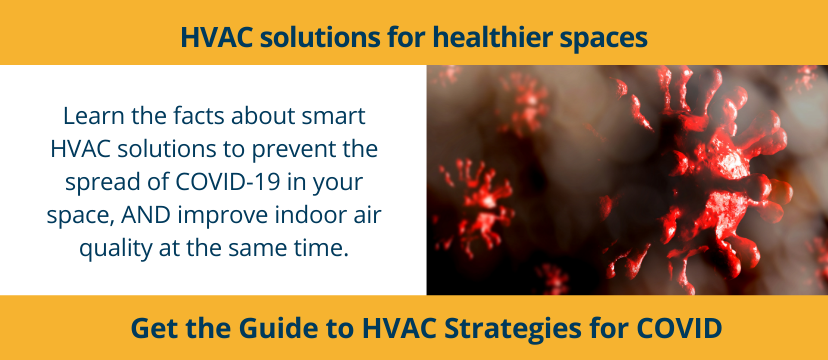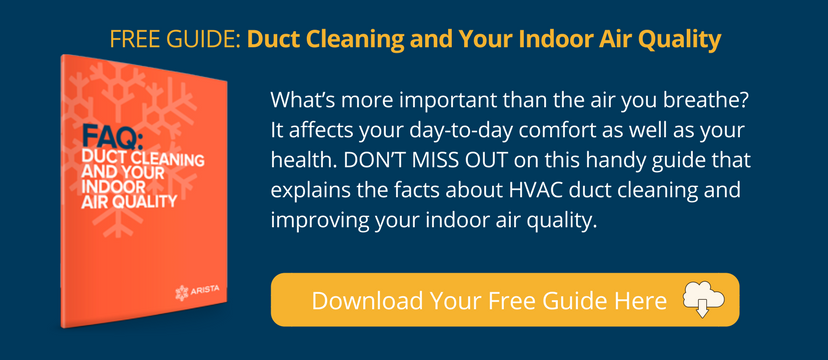Could there be a connection between your sneezing and your HVAC ducts? Well, it wouldn’t be the first time that dirty ducts turn out to be the culprit behind air conditioning allergies. Let’s look at the possible connection between your allergies and duct cleaning.
The link between allergies and duct cleaning
Does air duct cleaning reduce allergies? Consider this.
What happens when you blow dust off an object? Often the airborne dust blows back at you. For those with allergies, what happens next is a sneezing fit.
When your HVAC blows air through ducts coated in dust, you end up with airborne dust and dust mites in your home. Plus, pet dander, bacteria, viruses and mold spores. So it stands to reason that cleaning dust, allergens and other contaminants from ducts could improve air quality and reduce allergy symptoms.
Experts agree: a prominent allergist called duct cleaning “a common sense move” in a WebMD article.
Poor air quality in your home or business can lead to a laundry list of nagging health issues. Is anyone complaining about eye, ear and throat irritations? Is there a lot of coughing and sneezing going on? How about headaches and dizziness? Well, dirty ducts can make the occupants of your place sick.
Learn more: Could you have an air conditioner allergy?
Contaminants circulating through your ducts
When considering allergies and duct cleaning, remember that all your indoor air circulates through your HVAC system and ductwork. Here’s a list of some of the undesirables that can be released into the air.
Dust mites – It’s impossible to keep our homes dust-free when HVAC ducts are spewing out dust particles. Those particles quickly settle on surfaces. Dust is a big problem for allergy sufferers.
Pollen – It’s tracked in on your clothes and shoes. It enters your home through open windows and doors. It’s another allergy sufferer’s enemy and it’s dispersed throughout your space by your HVAC system.
Pet dander – We love our pets, but not everyone might share in our affection. The Asthma and Allergy Foundation of America estimates 3 in 10 people have allergic reactions to cats and dogs in the U.S. Your ductwork might be spreading dander throughout your space.
Smog – If you think once you shut your door, you’re safe from outdoor pollutants, you’re wrong. Pollutants creep into your home. In fact, the EPA says indoor air is at least 2 to 5 times more polluted than outside!
Volatile Organic Compounds – Most of us don’t think much about VOCs. But they’re all around us. VOCs are harmful gases that are given off by common household items. Cleaning fluids and even printers produce VOCs. Your HVAC system is circulating these VOCs through your ducts.
Mold and mildew – Moisture in your ducts can lead to mold and mildew. When looking into allergies and duct cleaning, if your ducts are moldy, duct cleaning is needed. Mold is responsible for many allergy symptoms.
Bacteria – If bacteria get into your HVAC system, they can circulate throughout your indoor space via air ducts and make people sick. In the worst case, you could end up with Sick Building Syndrome.
Viruses (including coronavirus) – There is increasing evidence that the virus that causes COVID-19 can remain airborne for hours or longer under some conditions. Some particles may stay in the air long enough to enter your HVAC air distribution system, and end up in your ducts. (Get answers to your questions about COVID and HVAC here.)
Learn more: Sick Building? Try Air Conditioner Preventive Maintenance
Other allergies and ductwork cleaning concerns
Not all the nasty stuff circulating from your ducts will make you sick. Some problems associated with duct issues are more uncomfortable than dangerous. Dirty ducts can produce odors and hot and humid air.
Learn more: Your HVAC System Could be the Cause of Your Smelly Building
What the EPA says about allergies and ductwork cleaning
While the EPA hasn’t offered a blanket endorsement on duct cleaning because of the lack of comprehensive information on allergies and ductwork cleaning, it has recommended that you consider duct cleaning in the following instances:
- There is substantial visible mold growth on surfaces such as ducts or other components of your HVAC system.
- Ducts are infested with rodent or insect vermin.
- Ducts are clogged with excessive dust and debris and releases these particles into your home from your supply registers.
Reducing allergies and ductwork cleaning benefits
- Improve air quality by removing contaminants from ducts.
- Eliminate odors by ridding your ducts of mold, mildew, rodent droppings and other nasty things.
- Reduce dust (one of the primary reasons for allergies and ductwork cleaning). Not only from the air, but from your furniture and other surfaces.
- Increase HVAC system efficiency by unclogging your ducts of debris. If dust and other stuff coats ducts, it interferes with airflow. Reduced airflow causes your HVAC system to work longer and harder. Clean air ducts reduce energy costs and extend the life of your system.
Do you need duct cleaning for allergies? Call for an inspection.
Were your ducts were properly installed? Has your HVAC system been regularly maintained through a preventative maintenance contract? If so, air duct cleaning for allergies might not be necessary.
However, sometimes ducts become damaged. Pesky rodents can enter ducts and create havoc. Call an HVAC professional to assess whether you need to address allergies and duct cleaning.
Wondering about connection between your allergies and ductwork cleaning? Choose an HVAC company experienced with ductwork cleaning and certified by the National Duct Cleaners Association, such as Arista Air.
For more information, check out this helpful guide: FAQ: Duct Cleaning and Your Indoor Air Quality.



